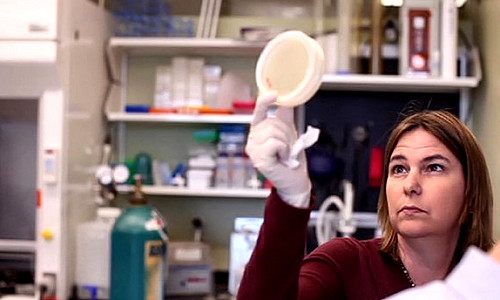Viruses subvert their hosts to pump out masses of new viruses. In an unusual twist, a researcher reports in the May 3 issue of Science that she used genetically engineered viruses that are noninfectious to humans to mass produce tiny materials for next-generation optical, electronic and magnetic devices.
“We’ve been looking at using genetic tools to grow semiconductor materials,” said author Angela M. Belcher , who this fall will join MIT as associate professor of materials science and engineering and biological engineering. “In this case, we took advantage of the viruses’ genetic makeup and physical shape to not only grow the material but also to help them assemble themselves into liquid crystal structures that are several centimeters long.”
Belcher and colleagues at the University of Texas at Austin are interested in using the processes by which nature makes materials to design new biological-electronic hybrid materials that could be used to assemble electronic materials at the nanoscale. Her research brings together inorganic chemistry, materials chemistry, biochemistry, molecular biology and electrical engineering. Belcher will be part of the MIT Department of Materials Science and Engineering and the Division of Biological Engineering .
Belcher’s approach is to use systems such as viruses that evolved over millions of years to work perfectly at the nanoscale, but to convince the viruses to work on technologically important materials. Belcher’s research team can evolve the viruses to work on the materials of interest over a period of months.
Building self-assembling and defect-free two- and three-dimensional materials on the nanometer scale is essential for the construction of new devices for optics and electronics. Researchers have been looking at ways to use organic materials to organize molecules of inorganic materials on the nanoscale. Fabricating viral films, Belcher said, may provide new pathways for organizing molecules to help create electronic, optical and magnetic materials.
“We showed that engineered viruses can recognize specific semiconductor surfaces, and these recognition properties can be used to organize molecules in inorganic nanocrystals, forming ordered arrays,” she said. “In this system, we can easily modulate the length of the bacteriophage (the type of virus) and the type of inorganic materials through genetic modification and selection. One can easily modulate and align different types of inorganic nanocrystals in 3D layered structures.”
This work is supported by the Army Research Office, the National Science Foundation and the Welch Foundation.
Story Source:
The above story is based on materials provided by MIT News Office.





